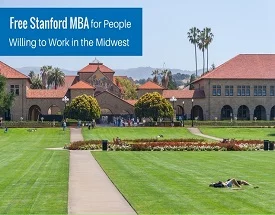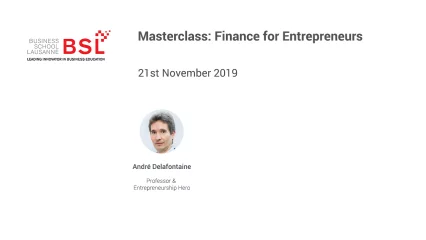The fellowship covers tuition and associated fees, or about USD 160,000 in total, and will be available to students in next year’s entering MBA class who agree to work in the Midwest for at least two years.
A bond with the region required
Applicants must be US citizens or permanent residents and apply to the Graduate School of Business and the fellowship in the first or second round of admissions. (The first-round deadline just passed, but second-round applications aren't due until January 10.) They must submit an additional essay on how they're connected to the region and intend to contribute to it. Prospective fellows must get into the MBA programme and be deemed in need of financial assistance.
The free Stanford MBA is designed for people who are “committed to economic development in underserved regions of the United States.” Prospective fellows must show strong connections with at least one state in the Midwest—Illinois, Indiana, Iowa, Kansas, Michigan, Minnesota, Missouri, Nebraska, North Dakota, Ohio, South Dakota, and Wisconsin fit the bill—such as living there, currently or for at least three consecutive years in the past, or being a graduate of a Midwestern high school.
Check out: Win USD 25,000 in an MBA Scholarship Contest
Then, within two years of graduating from Stanford, they will be required to work in the Midwest for at least two years in a position “that will contribute to the region’s economic development.”
The programme seeks people who are interested in bringing everything that they learned back to their region to develop it, said Simone Hill, an assistant director for MBA admissions at Stanford, who is in charge of the fellowship.
So we don’t have any specific stipulations on what we mean by ‘having an impact,’ because we know there are so many different ways you can do that.
She pointed to a few areas: government, social sector, grassroots activity, entrepreneurship, and efforts to attract capital or develop new energy sources.
The Midwest is home to many struggling farms, the beleaguered Detroit and the Rust Belt region.
Bigger plans ahead
The programme is also about Stanford itself, which is trying to improve the geographic diversity of its business school class. Following the pilot, the plan is to add other US regions (they're thinking of the Southeast for next year) and eventually to award up to eight of these fellowships a year. The programme is modeled on the Stanford Africa MBA Fellowship, which is extended to as many as eight citizens of African nations who need financial aid, with similar stipulations.
Stanford started with the Midwest partly because of relationships with alumni and companies in the region, including General Motors Co., of Detroit, and Eli Lilly & Co., of Indianapolis. Hill said:
“When we look at our country, and we think about different places where there’s still a lot of room for growth and development, the Midwest was a big part of that”.
Source: Bloomberg



